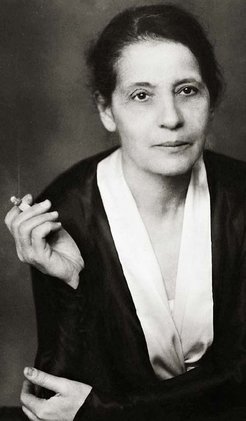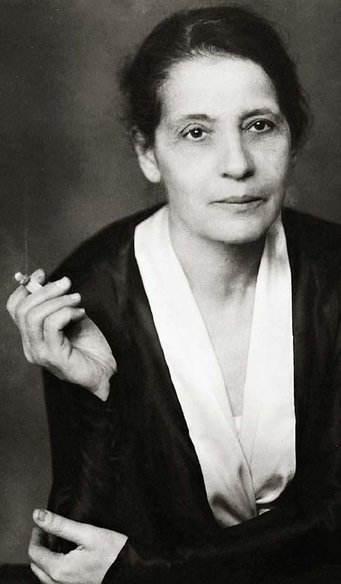Portrait of Lise Meitner
When the Kaiser Wilhelm Society convenes for its annual general meeting at Harnack House in the summer of 1931, guests can expect an innovation: one of the three lectures - academic highlights at the opening of the meeting - will be held, by the for the first time in the history of the KWG, a woman. The physicist Lise Meitner holds a talk on the "On Interrelations between Mass and Energy" , a pioneering field of modern physics, which has begun to capture wider public interest thanks to Albert Einstein and his theory of relativity.
Text: Susanne Kiewitz

When the Kaiser Wilhelm Society held its Annual General Meeting at Harnack House in summer 1931, a change that was to turn the status quo upside down awaited the guests. One of the three testimonial lectures – academic highlights at the start of the meeting – was held by a woman for the first time in the history of the KWG. The physicist Lise Meitner explored “correlations between mass and energy” which was a pioneering field in modern physics that also attracted public attention thanks to Albert Einstein and his theory of relativity.
Presenting this important lecture was an honour. Lise Meitner was at the peak of her career. She was head of department at the nearby Kaiser Wilhelm Institute for Chemistry, lectured as a professor at the University of Berlin and was a welcomed guest at scientific conferences. Together with her research partner Otto Hahn, she was nominated for the Nobel Prize in 1924 and 1925 for her work on the new element protactinium. She was also doing well on a personal level, earning just as much as her colleague Otto Hahn until his promotion to head of Institute. Moreover, no differently to male administration members, she lived in a spacious apartment at the Institute’s villa where a house-keeper took care of daily chores.
Lise Meitner’s success could not have been anticipated, as, like most women, she only gained access to university via protracted indirect routes after her teaching exams. She was therefore already 23 years of age when she enrolled at the University of Vienna in 1901 to study her chosen subjects of physics and mathematics, which was highly unusual for a woman: besides her, only Selma Freud, the second wife of the world-famous psychologist, obtained a doctorate in physics at the time. The discipline was undergoing an almost unique transformation after Max Planck had paved the way to the new physics with his quantum theory. This appealed so strongly to the young physicist that she turned down an offer to work in industry after her doctorate in order to learn more about the emerging research field from Planck in Berlin.
Although Planck – very much a man of his time in this respect – was also sceptical about the scientific ambitions of women and Prussian law prohibited women from studying, Meitner was given permission to attend his lectures after a personal meeting with him. Moreover, he made her his assistant in 1912, enabling her to pursue a career in science. Meitner also established friendships with Planck’s family privately.
However, she was only able to conduct her own re-search after she courageously approached the head of the University Institute for Physics who then arranged collaboration with Otto Hahn. Both scientists had a very keen interest in radioactivity phenomena and, being almost the same age, quickly found common ground. Despite these ideal circumstances, their collaboration was initially blocked as the Chemistry Institute’s administrative regulations firmly excluded women; in contrast to Planck, its head, Emil Fischer, made no exceptions. Otto Hahn eventually found a way around this: His temporary laboratory in the Institute’s former wood workshop was largely separated from teaching activities and had its own entrance. Despite her ignominious treatment, in 1954 Meitner looked back on this time as the “happiest years” of her career: “Radioactivity and nuclear physics were making incredibly rapid progress at the time. There was an amazing, surprising new discovery almost every month in one of the laboratories working in this field ... we developed very good scientific and personal relationships with our young colleagues at the nearby Institute of Physics ... we were young, jovial and carefree.” However, Hahn and Meitner only began addressing each other informally fourteen years later.
In 1913, the research team moved to the new KWI for Chemistry in Dahlem. The stability they found there was nevertheless soon shaken by the World War, which Meit-ner spent as a radiographer and Hahn as a member of Fritz Haber’s special war gas unit. Although both were directly faced with the horrors of the battlefield, they generally refrained from voicing criticism of the war in keeping with the patriotic and nationalistic mood of the times. At the end of the war, they soon resumed working together, Meitner now as head of department.
Lise Meitner was not the only woman to make her mark in the male-dominated world of science. At the KWG, which was more progressive about employing women than other institutions, a total of 113 women were appointed to senior positions between 1912 and 1943. One of them was Meitner’s friend Elisabeth Schiemann who conducted research in Dahlem as a plant geneticist and was also a regular visitor to Harnack House. Another was Cécile Vogt, who, together with her husband Oskar, established the KWI for Brain Research – the largest and most significant institution of its kind in the world at the time – in the northern part of Berlin. She shared her difficult experience of forging a career in science with other women, prompting the foundation in 1926 of the Deutscher Akademikerinnenbund (DAB) (German Federation of Female Academics) by the agronomist Margarete von Wrangell, the economist Marie-Elisabeth Lüders and the publicist Agnes von Zahn-Harnack, Adolf von Harnack’s daughter.
Although Lise Meitner later emphasized that she had little interest in women’s rights at this time, she was a member of the DAB executive, which also met regularly at Harnack House from 1930 to 1932. She also presented the DAB at the congresses held abroad by the International Federation of University Women and had a say in the selec-tion of German applicants for international scholarships. As the DAB was threatened with enforced conformity after the Nazis came to power, its executive resigned en bloc in 1933 and the Federation did not reform in its current guise until after 1945.
The beginning of Nazi rule had immediate implications for Lise Meitner. A liberal woman in a management role – especially a childless one – did not concur with an ideology that reduced women to their role of birthing mothers. Of even greater significance was the fact that Lise Meitner came from a Jewish family. Despite converting to Christianity in 1908, she remained a “Jewess” in Nazi terminology and the University of Berlin withdrew her authorization to lecture in 1933 on these grounds. She was nevertheless initially able to keep her position at the KWI owing to her Austrian citizenship. As the mood at the Institute was rather non-political and Meitner did not have to endure any anti-Semitic attacks from her colleagues in the beginning, little changed for her at first. In retrospect, this was an extremely important period scientifically: from 1935 Meitner resumed her intense collaboration with Otto Hahn and the chemist Fritz Straßmann. They sought to produce transuranics – very heavy artificial elements – by bombarding uranium with neutrons.
In the meantime, Hitler’s foreign policy was becoming increasingly aggressive. The annexation of Austria in March 1938 ultimately brought Lise Meitner into acute danger, as she consequently lost her status as a foreign national which had guaranteed her safety from the Third Reich’s race laws up to that point. Otto Hahn, amongst others, urged Meitner to emigrate and put her in contact with his Dutch colleague Dirk Coster, who would take Meitner to safety abroad. On 13 June, the physicist left Berlin with just two small suit-cases, having had no time for further preparation. The escape also succeeded thanks to Coster’s close links with the Dutch authorities who allowed Meitner to pass through without valid papers. Meitner travelled from the Netherlands to Stockholm where – awaited by friends and relatives – she would work as a guest at the Nobel Institute.
However, Meitner had not only lost her former position but also her assets and had to learn a new language at the age of sixty. It took many months before she was finally able to move into her own apartment with her sister and brother-in-law. Despite the gloom of everyday life, the main complaint she expressed in her letters was the limited employment opportunities: 'External things do not really make much difference to me, although they obviously contribute to my sense of rootlessness, having spent six months living out of a suitcase,” she wrote to Elisabeth Schiemann on 17 January 1939. 'But the lack of work is a great sufferance, as it means my life is devoid of any meaning.”
It was under these circumstances that her famous correspondence with Otto Hahn, who continued the experiments on transuranic elements with Straßmann in Berlin, took place. The letter of 19 December 1938, written just before midnight, is the first document of the discovery of nuclear fission. 'Actually, there is something about the radium isotopes that is so remarkable that for now we are telling only you,” wrote Hahn. 'It could be an extraordinary coincidence, but we are increasingly coming to the awful conclusion that our Ra[dium] isotopes are not behaving like Ra but instead like Ba[rium]. I agreed with Straßmann that we would only tell you for the time being. Perhaps you can come up with some sort of fantastic explanation. We ourselves realize that it can’t actually burst apart into Ba.”
Further correspondence provided more details, as Hahn was already preparing the publication of the chemical results. 'We cannot keep our results quiet, even if they seem physically absurd. You would be doing us a great service if you could find a solution,” he wrote a few days later, now combined with the urgent question of whether it was energetically possible that the uranium nucleus had “burst apart”. At the beginning of January 1939, Meitner finally confirmed this hypothesis: “I am now almost certain that you really do have fragmentation into Ba.” This was based on calculations on energy correlations produced by Meitner and her nephew Otto Robert Frisch – also a physicist – using Hahn’s experimental findings. The basis was Einstein’s formula on the conversion capacity of mass to energy, a subject on which Meitner had lectured at Harnack House in 1931.
The results of the teams working in Sweden and Berlin, which left no doubt as to the quantities of energy involved in splitting the atom, stunned natural scientists all over the world. When the first nuclear attack on Hiroshima dramatically illustrated the devastating, destructive capability of nuclear weapons, not only Otto Hahn, but Lise Meitner, who lived in seclusion in Sweden, was thrust into the public spotlight. The Nobel Prize committee nevertheless overlooked Meitner’s contribution when it awarded the Prize solely to Otto Hahn in 1945. The researcher has remained in Hahn’s shadow until the present day. Only in recent times has there been greater recognition of her contribution to the discovery of nuclear fission and her role as a pioneer in radiation physics.












